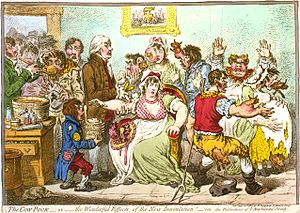Innovation and Bananas

Start from the top.
We’ve all heard the admonition, “If it ain’t broke don’t fix it.” We often take it at face value – if something is working, don’t make changes. On the other hand, we usually roll our eyes when a colleague justifies a process by saying, “Well, we’ve always done it that way.”
So which is it? Should you accept a process simply because it’s traditional? Should you assume that it doesn’t need attention? If your business processes are working reasonably well, should you never review them? Should you never seek to improve a process that’s fulfilling its basic objective? Is it OK to accept that we’ve always done it that way?
When I think about these questions, I think about bananas. I’ve always peeled bananas from the stem. It works reasonably well most of the time. But occasionally the stem breaks off awkwardly and mashes the end of the banana. I’ve also noticed recently that snapping the stem can aggravate the arthritis in my thumbs. But, hey – it’s not a big deal. I’ve always done it that way. Why would I change something that’s not broken?
Then I learned that monkeys peel a banana from the opposite end. This is actually the top since bananas grow “upside down”. You simply pinch the top and the peel separates; then you pull it back. It’s simple, easy to do, essentially foolproof, and it doesn’t hurt arthritic thumbs. (Here’s an illustrated guide).
Now I peel bananas from the top rather than from the bottom. Each time I do, I think about innovation. It’s a simple thought – I should ask more questions about how I do things. Why do we things the way we do? It’s a simple process – we just observe and question. It’s so simple, in fact, that we can learn it from monkeys.
Observation and Innovation

Don’t be cowed.
In the mid-1790s, an English country doctor named Edward Jenner made a rather routine observation: milkmaids don’t get smallpox. Milkmaids were often exposed to cowpox, a disease that’s related to smallpox but much less deadly. Cowpox gave the milkmaids flu-like symptoms that were distressing but certainly not lethal. Jenner guessed that the cowpox also conferred immunity to smallpox.
Jenner wasn’t the first to observe the cowpox effect but he was the first in the western world to act on his hunch. He created a vaccine from the scraping of cowpox pustules and administered it to some two-dozen people. They all acquired the immunity to smallpox. Jenner conducted experiments to demonstrate the treatment’s efficacy as well as the biological mechanisms in play. As a result, he is often described as the father of modern immunology.
Jenner’s breakthrough came from simple observation. He paid close attention to the world around him, observed an anomaly, and acted on it. Observation provides a foundation for both critical thinking and innovation. If necessity is the mother of invention, then observation is the grandmother. One has to observe the necessity in order to address it. (If a necessity happens in the forest and no one observes it, is it really necessary?)
How does one learn to be a good observer? Interestingly, most critical thinking textbooks don’t address this. Rather, they teach readers how to ask insightful, clarifying questions. That’s useful, of course, but also somewhat limited. Observation is merely a continuation of questioning by other means. Much more than questioning, observation can reveal fundamental insights that produce important innovations – like Jenner’s.
How does one become a good observer? Here are some thoughts I’ve gleaned from reading and from my own experience.
Pay attention – this may seem obvious but it’s hard to do. We’ve all had the experience of driving somewhere and not remembering how we got there. The mind wanders. What to do? Remind yourself to stay in the moment. Make mental notes. Ask yourself why questions. Mindfulness training may help.
Keep a journal – you can’t observe everything a given moment. Observations grow and change over time. You may have half a good idea today. The other half may not occur to you for years. Steve Johnson calls it a slow hunch. The trick to a slow hunch is remembering the first half. If it’s written down, it’s much easier to recall. (Indeed, one of the reasons I write this blog is to remember what I’ve learned).
Slow down – it’s much easier to think clearly and observe effectively if you take your time. The pace of change may well be accelerating but accelerating your thinking is not going to help you.
Pay attention to System 1 – your fast, automatic system knows what the world is supposed to be like. It can alert you to anomalies that System 2 doesn’t recognize.
Enhance your chance by broadening your horizons – Pasteur said, “Chance favors only the prepared mind.” You can prepare your mind by reading widely and by interacting with people who have completely different experiences than yours. Diversity counts.
Look for problems/listen to complaints – if a person is having a problem with something, it creates an opportunity to fix it.
Test your hypothesis – in other words, do something. Your hypothesis may be wrong but you’ll almost certainly learn something by testing it.
Observing is not always easy but it is a skill that can be learned. Many of the people we call geniuses are often superb observers more than anything else. Like Edward Jenner.
Postscript – Jenner inoculated his first patient in May 1796. Once Jenner showed its efficacy, the treatment spread quickly. So did opposition to it. In 1802, James Gillray, a popular English caricaturist, created the illustration above. Opponents claimed that cows would grow out of the bodies of people who received cowpox vaccines. Anti-vaccine agitation has been entwined with public health initiatives since the very beginning.
Vuja De

I’m having déjà vu and amnesia at the same time.
I tell my students that, if they want to be more innovative, they need to improve their observational skills. I encourage them to think like an anthropologist – to carefully observe what’s going on around them and how people interact with each other. Observing complex social behavior is no different in Denver than it is in, say, Papua New Guinea.
To practice their observational skills, I ask students to notice something new when they commute to work. They’ve driven that route hundreds of times but I’m sure that there are many things they haven’t noticed. So I ask them to make a special effort to notice something new each time they drive to and from work. I also ask them to keep notes on what they’ve newly noticed – that is, what they’ve been missing.
We then discuss what they haven’t seen. Students typically report that they’ve missed seeing an entire category of things or people. Perhaps they missed certain types of buildings or businesses. Perhaps they hadn’t noticed people waiting at a bus stop or the way people dressed for different weather.
Students often ask me, “How can I notice what I don’t notice?” I typically advise them to ask their spouse. After doing something together, ask your spouse what he or she saw. You may be surprised at how different your observations are. For instance, I tend to miss green stuff – plants, flowers, trees, etc. I’m sure that my wife never does.
By and large, my students are surprised at how much they’re missing. It’s a fun exercise as well as being useful. I feel like I’m helping to prepare a bunch of amateur anthropologists – or maybe police detectives.
It was only last night, however, that I discovered that there’s actually a term for noticing what you haven’t noticed. I heard Tom Kelley, one of the founders of IDEO, give a presentation at the University of Denver. He noted that we’re all familiar with the term déjá vu – we see something for the first time but we sense that we’ve seen it before. He suggests that we turn the term around – vuja de – to describe something that we’ve seen so many times that we fail to notice it.
As an example, Kelley described watching an in-flight safety demo. He’s seen it thousands of times. But recently he noticed that the air mask that drops down in an emergency really does need to be redesigned. As he pointed out, you can’t tell if it’s working or not because the bag doesn’t inflate. The only way you can tell that it’s not working is by passing out. That’s probably not the best human interface.
We miss important clues simply because we see them so many times. They’re hidden in plain sight. By improving our observational skills, we can learn more about the world around us and find many more opportunities to innovate. It’s as simple as vuja de.
(To find Tom Kelley’s books, click here, here, or here. They’re all good).